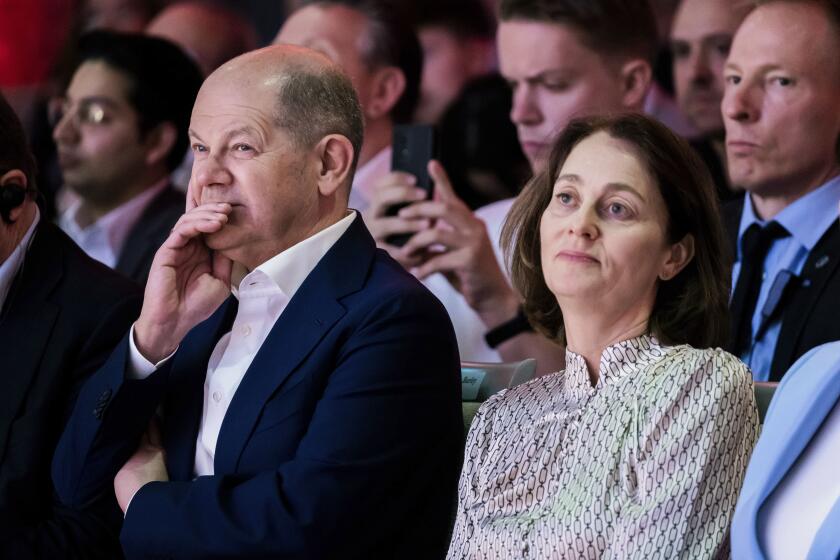Yeltsin’s Cabinet OKs Its Boldest Reform Plan : Economy: The 3-year program is intended to put Russia firmly on road to capitalism and bring era of recovery and growth.
Determined to put Russia firmly on the road to capitalism by fostering full, free-market competition and ending most state controls on the economy, President Boris N. Yeltsin’s Cabinet gave preliminary approval Thursday to its boldest reform program.
Focused on the medium term, the program is aimed at taking Russia from its present period of stabilization after the collapse of the Soviet Union into an era of recovery and growth, a transition other former socialist economies have found difficult to achieve.
Alexei V. Ulyukayev, the Cabinet spokesman, said that despite its radical nature, the program--calculated to span three years--won broad government approval and will be presented to the country’s legislature after final corrections.
The core of the program, according to a top government economist who helped draft it, is the promotion of entrepreneurship, both domestic and foreign, through the removal of government barriers to private business activity.
“We have a real possibility to change the economic system of Russia and to introduce a real market economy here,” the official said, asking not to be quoted by name. “The old system of state and administrative management is disappearing, but the period for the introduction of a free-market system is very short.”
The plan envisions a rapid, massive selloff of state-owned enterprises to investors, company managements, employees and foreign firms under the privatization program, announced two weeks ago, that will give every Russian certificates to buy shares of stock.
“The major driving force of a market economy is the entrepreneurial spirit and competition based on private property,” the plan says in outlining its “conceptual underpinnings.” “Privatization and other institutional changes are necessary to nurture this spirit, to motivate people and to create rules of commercial behavior that allow private businesses to flourish.”
The plan provides as well for the extensive development of private farming, the freeing of foreign trade from most state controls and the financing of new investments through individual savings, pension plans and stock exchanges.
The plan also calls for the closure of those enterprises, certain to number in the thousands, that cannot make a profit without the government subsidies they have had for so long.
Like the freeing of prices from state control in previous years, this has become the key psychological and political problem blocking further reform. But the plan virtually demands “the elimination of inefficient enterprises whose costs of production are higher than the economic value of the goods they produce.”
“These unprofitable ventures must be permitted to fail so that their resources (raw materials, labor and so forth) may be reallocated by market forces to efficient enterprises,” according to a copy of the still-unpublished plan provided to The Times.
“This transitional process, while painful, is necessary to clear the way for effective investments and sustained economic growth. The economy will grow as the market process redistributes resources from inefficient to efficient enterprises.
“The development of efficient, market-oriented enterprises will ensure society’s well-being by creating employment opportunities as well as products actually sought by consumers.”
The government, however, was forced Thursday to pull back the long-delayed bankruptcy law before its passage by the Supreme Soviet, the Russian legislature, for under its definitions virtually all the enterprises in the country are technically bankrupt because a severe cash shortage has left them unable to pay their bills.
Spokesman Ulyukayev said that the government is still working on ways to clear the more than 2 trillion rubles--about $20 billion--in debts that Russian companies owe to each other without increasing inflation beyond control.
The new plan is intended to go into effect in mid-1993 and run for two to three years, according to economists who prepared it, and by its completion it aims at annual growth of 3% to 4%. The state-owned sector of the economy should be less than 40% of the gross national product at the end, with private enterprise, now no more than 5%, increasing to 60%.
According to the economists who drafted the program, the government must bring inflation, now 20% to 25% a month, down to 3%, reduce the state budget deficit to no more than 3% of the country’s total output and make the ruble convertible into foreign currencies before it undertakes the program.
“We still have a great deal to do in stabilizing the economy,” one of the small group of young, pro-market economists said, “but it is also very important to lay the foundation for what we do next.”
In removing almost all government controls on the economy, the next stage of the reform program will attempt to create a “level playing field” for private and foreign investors whose entry into the economy has been largely blocked.
“The objective is to create conditions for economic growth, and economic growth will depend on two things, the increase in the domestic savings rate and the creation of a mechanism to turn these savings into investment,” Ulyukayev said in announcing the Cabinet’s approval of the program.
“It is also a program of de-nationalization of the Russian economy, of abandoning state interference with the economy in terms of its financing from the budget and a reduction of budget expenditures on items that are not suitable for the state, such as centralized investments.”
Russia launched its economic reform program in January when Yeltsin lifted most state price controls and the government moved to dismantle the old Soviet central planning system.
Inflation has soared since then, and industrial production has fallen by more than 13%. A report from the government’s statistics office this week described the situation as critical in several key industries--among them oil, petroleum products, construction materials, fertilizers and chemical products.
More to Read
Start your day right
Sign up for Essential California for news, features and recommendations from the L.A. Times and beyond in your inbox six days a week.
You may occasionally receive promotional content from the Los Angeles Times.






